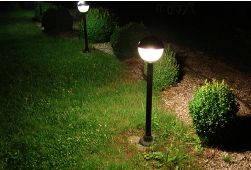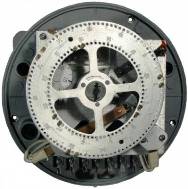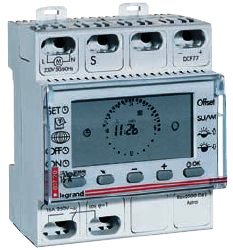Categories: Interesting electrical news, Home automation, Electrical Reviews
Number of views: 60460
Comments on the article: 5
Astronomical timers for controlling lighting by time
 Nowadays, photosensors are most often used to control lighting on the street and the territory adjacent to the house. (twilight switches).
Nowadays, photosensors are most often used to control lighting on the street and the territory adjacent to the house. (twilight switches).
The photosensors turn on the light depending on the amount of natural light. Somehow it turned out that everyone forgot a little the most popular technical solution relative to the recent past - turning lights on and off with daily time relay.
Even before the advent of photoresistors and other photocells, various automatic devices with clockwork. These devices turned on and off the lights at a predetermined time of day. For example, were widespread 2РВ relay (single-program) and 2РВМ (two-program).
The principle of operation of these relays was based on the rotation of a software disk with holes into which special pins were screwed in according to a given program. The disk rotated using a clockwork. The clockwork spring was started by an electromagnet. When the disk was rotating, the pins pressed the microswitches and turned on and off the lighting.
 This lighting control method has its advantages and disadvantages. The advantages are mainly related to the fact that the operation of the lighting system is not affected by any random exposure. A relay is a relatively simple device and can be placed absolutely anywhere, including indoors, while photosensor must be located in the place of control of natural light. In addition, there is no need to determine the necessary threshold of illumination.
This lighting control method has its advantages and disadvantages. The advantages are mainly related to the fact that the operation of the lighting system is not affected by any random exposure. A relay is a relatively simple device and can be placed absolutely anywhere, including indoors, while photosensor must be located in the place of control of natural light. In addition, there is no need to determine the necessary threshold of illumination.
The main disadvantage of using a daily time switch is that the time of sunrise and sunset is constantly changing, which requires regular adjustment of the mechanism to new values of the time of sunrise and sunset, which is very inconvenient. If you do not, then after a certain time, such relays gave large errors when turned on, for example, they turned on the lamps, when this was completely unnecessary due to a fairly good level of natural light.
With the rapid development of electronics and microprocessor technology, more and more intelligent devices appear that implement reminiscent of old proven technical solutions at a higher level.
Since in some cases it is incredibly difficult to limit a conventional light sensor from accidental flare, a device can be of help in which there is no need for an external light sensor - digital astronomical timer.
In principle, such a device is similar to time relay with the clockwork of the past. But unlike their predecessors, modern devices of this type are able to automatically calculate the time of sunrise and sunset and to switch in the output circuits (turning on and off the light sources) only when there really is a need for it.
Digital astronomical timers are produced by a large number of manufacturers and according to their technical characteristics they are all very similar.
An example of such a device is astronomical timer Rex 2000 companies Legrand.
In order for the Rex 2000 astronomical timer to correctly determine the time of sunrise and sunset in the timer memory during its initial configuration, it is necessary to enter the date, time and local coordinates (longitude and latitude) of the area where it will be operated. At the same time, the Rex astronomical timer is suitable for use anywhere in the world..

Astronomical timer Rex2000 the company Legrand
Timer Switching (light source control) occurs without the use of a photosensitive element. In order to save energy at night, a programmed timer shutdown is possible. Switching time is easily determined by the segmented display.
It is possible to correct the on and off time within +/- 60 min from the values of sunrise and sunset calculated by the astronomical timer. In addition, the control input “S” of the timer allows you to turn on the timer, regardless of the current program. According to the manufacturer, the accuracy of the timer is +/- 1 s / day.
The timer automatically switches to "winter" / "summer" time. There is a sealable lid. FACE programming interface. Different models of timers can receive power from a voltage of 230 V or 24 V. Operating temperature -20 ... + 55 aboutC. Degree of protection - IP20.
There is an astronomical timer model that can control two channels at once. The timer has 1 or 2 switching contacts for 16 A for a purely active load or 4 A for inductive (with cos phi = 0.6). If you need to connect more powerful lamps through a timer, then in this case you need to connect the lamps through electromagnetic starters. In this case, the astronomical timer will already control not directly the line, but the coil of the electromagnetic starter.

Astronomical timer connection diagram Rex2000
For some manufacturers, the astronomical timer has the function of automatically determining the time of sunrise and sunset from the entered city name and current date. In addition, the timer may have a built-in counter of the time worked by the timer and the amount of load on, the ability to enter a password in order to exclude someone else's interference in the operation of the device.
Most automatic timers are available for mounting on DINrail (standard metal rail 35 mm wide) and have a simple wiring diagram.
The astronomical timer, while preserving all the advantages of a clockwork device (the main advantage is that there is no need to install a light sensor) controls the light sources depending on natural light (though determined by calculation).
See also at e.imadeself.com
:
